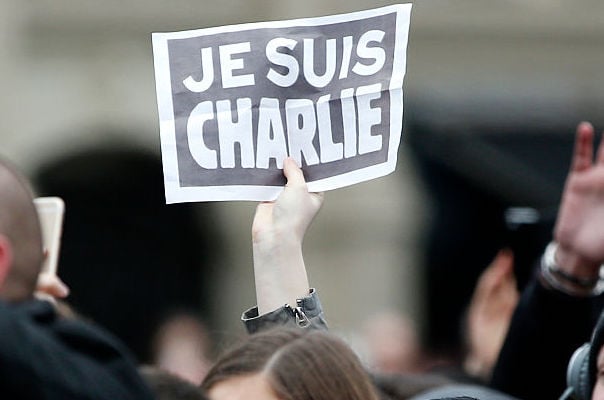
Photo: YOAN VALAT/AFP/Getty Images
Organizers of an Israeli exhibition dedicated to the memory of the victims of last year’s terrorist attacks on the French satirical magazine Charlie Hebdo have been criticized for allegedly censoring several caricatures in the show.
One work was removed and another was partially covered at the exhibition titled Apres Charlie, held in the French Institute in Tel Aviv, following a request by the French Embassy which expressed concern over the depiction of the Prophet Muhammad, the Times of Israel reports.
The two affected caricaturists, Vladik Sandler and Roy Friedler, have condemned the censorship.
Sandler’s cartoon—which was removed from the exhibition—depicts Muhammad posing as a nude model for the five murdered cartoonists in a live drawing class.
Meanwhile, Friedler’s depiction of Muhammad was partially covered with a sticker. His submission shows the murdered cartoonists arriving at the gates of heaven only to find that Muhammad is waiting at the reception. A caption says “Friends, I think we’re screwed.”
On Sunday, Sandler took to Facebook to comment on the incident. “I sent two caricatures to the exhibit, and both of them touched in one way or another on the fact that since the attack, Muhammad is not being drawn in the newspaper. To my great surprise, when I arrived at the opening evening of the exhibit, I discovered that after a special request from the French Embassy, one of my caricatures had been removed.” The post has since been removed, but not before Israeli media reported on the story.
The cartoonist insisted that the depiction of the Prophet was legitimate because it was in the context of a tribute to the killed French caricaturists.
However, he concluded, “I have been left with a feeling of terrible sourness that those people, whose only crime was dark humor, died for naught and that any symbolic heritage that they might have wanted to leave behind—has gone to the trash or is hiding behind red stickers of censorship.”
Friedler, the other censored cartoonist, also went public decrying the censorship. He reportedly told the Israeli paper Globes, “They asked me to participate in the exhibition, and one day before the opening they told me that there was a problem with [my cartoon].
He explained, “Because I only sent in one caricature, they wanted to put it in and also to satisfy the embassy, but they said that [the picture] would either be censored or not there at all.”
The cartoonist argued that the censorship “messed up the punchline, but also sent the message that the pencil has not beaten out the Kalashnikov.”
The censorship allegations were vehemently denied by organizers at the French Institute in Tel Aviv. The Times of Israel reports that spokeswoman Ann Gollion told NRG “To the best of my knowledge, no caricature was removed from the wall.”
She went on to deny involvement from the French Embassy, “No pressure at all was put on us by the French Embassy, and there was no political interference.”